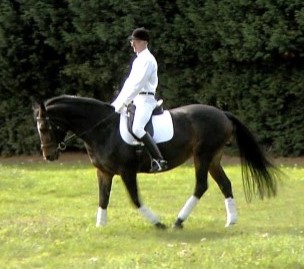Equinamity-A Revolution in Horse and Rider Training

There will be many Principles presented in this blog. However, this one is a key starting point.
For it to happen, there must be a realistic assessment of Inputs and Outputs.
Success with horses can only really happen if it is based on realistic Inputs and Outputs. The first photo above shows a correct match between horse and rider.
The next three photos show obvious mismatches.

This is definitedly not the case in the above three examples. They show in a very practical way a wrong starting point to achieve success with horses. They show exaggerated differences.
In most cases, horse and rider must be matched, based on realistic Inputs and Outputs. This must start with sizing. And by this we are not referring just to the horse, but also to the rider. For many horse owners, the horse becomes a lifelong companion. So a good match is essential.
Getting, owning and keeping a horse is a very serious undertaking.
In addition, the horse can play as important a role as any other member of the household. In some cases, even more important.
I hesitate to use the word family in the traditional sense. Since for many horse owners, the horse is either more important or in some cases has replaced the family altogether. In those cases where extensive bonding exists, the mental and emotional aspects play a large part in the relationship. Even larger than the physical, or riding, part.
So before you admit any horse into your stable (or house) and heart, an actual or prospective horse owner needs to undertake some serious reflection.
This is because compatibility is vital. And that has to be based on a range of qualities of both horse and prospective owner.
So what are these inputs?
Below is a broad list of Inputs. It reveals the extent of the complex issues involved.
Mental/emotional condition
Physical condition
Matching the horse and rider
Size and weight
Natural talent
Coordination
Intelligence
Personality
Attitude
Moods
Experience
Approach to discipline
Level and type of training
Performance standards and expectations
Matching the horse to the work
Matching the rider’s demands to the horse’s level of training/capability
Knowledge of physical/muscular constraints
Quality of instructions
Attitude by the handler to “anticipation” by the horse
The majority of these are straightforward qualities. The one which has both a special significance and broader interpretation is “anticipation”. This is because it encapsulates the rider/handler’s approach to discipline.
For example, if the horse jumps to the back of its stable and looks frightened when owner/handler enters, then it is obvious that a serious communication disconnect exists. This will require a great deal of work before a productive and happy relationship can be created. On the other hand, if a horse looks forward to gretting its owner/handler, and willingly undertakes new work, then it is obvious that a good relationship exists.
It is also important to point out that a relationship with a horse should not descend into a never-ending wish to satisfy all of the horse’s whims. Horses are like little children and quickly learn how to get special treats or whatever else they want.
However, for the most part the items in the above list are substantially objective. In general, they can be accepted for what they are. Yes, moderate degrees of difference can be accepted between the match of horse and rider. This may involve something which requires, say extra work or training for a less experienced rider to catch up with an experienced horse.
And realistic. If not, a successful relationship between a horse and rider is much less likely.
The three photos above indicate more extreme examples of mismatches.
This is where assistance provided to prospective owners and inexperienced riders by knowledgeable riders and trainers is invaluable. They can play a big role in ensuring that the differences are kept within a manageable level.
This will not only keep a new horse owner’s family and friends happy, but also increase the likelihood of a safe and enjoyable partnership.
Overall compatibility is a starting principle. Horse owners and riders must avoid mismatches. This is because extreme differences between horse and rider complicate successful relationships. This may seem obvious but that doesn’t make it any less important.
The above photos show several examples of what happens if Inputs and Outputs are not matched. Even if they are a bit exaggerated, they reveal some serious practical problems.
There is usually a common-sense explanation which is available for the need regarding sensible matching.
Otherwise, if the horse and rider are not matched, the extreme differences between them will make a successful relationship much more difficult.
This leads us to the first Principle.
If these are chosen well, then there is a good chance that a harmonious working relationship will develop.
As shown in the next blog/post: Equi-note #9 Matching Principle helps Working With Good Harmony.
Now we need to have a look at the Outputs.